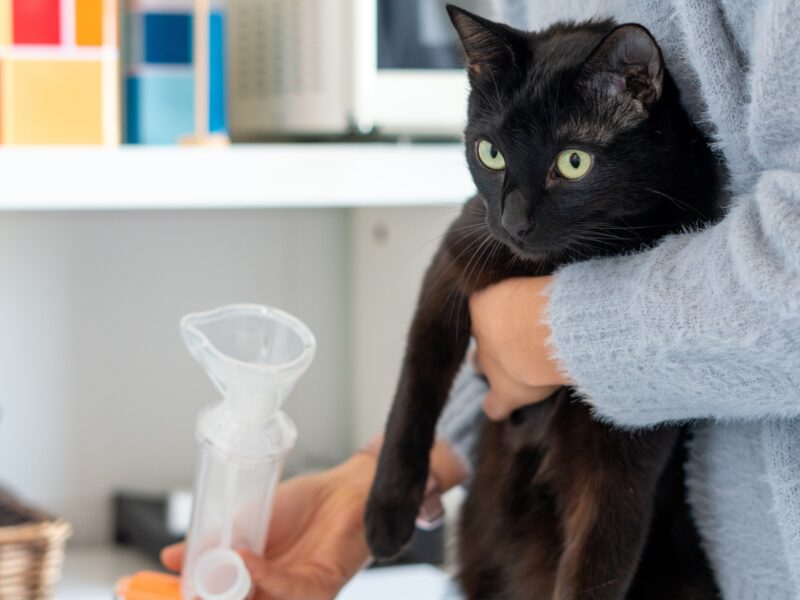Pumpkin Safety For A Pet-Friendly Halloween

As Halloween creeps closer, the time to carve pumpkins with spooky faces grows near, and since pumpkins are safe for both cats and dogs to eat, creating jack-o-lanterns is an activity your furry family members can participate in, with appropriate supervision.
Dr. Katie Tolbert, a clinical associate professor in small animal and comparative gastroenterology at the Texas A&M School of Veterinary Medicine and Biomedical Sciences, says families can safely carve pumpkins around their pets, as long as owners remain vigilant about the amount of pumpkin a pet eats, possible choking hazards, and the pumpkin’s freshness.
Safe Pumpkin Treats In Moderation
In general, pumpkin can be an excellent treat for cats and dogs because it is both tasty and low in calories, making it a healthy alternative to traditional treats.
“Pumpkins are roughly 90% water, so they can be filling for a pet without increasing their caloric intake, which is beneficial for overweight or obese pets,” Tolbert said.
Letting pets munch on the insides of a fresh pumpkin, including the seeds and fibrous strands, can provide other health benefits, specifically by providing fiber that can ease digestive issues, but only if eaten in small amounts.
“Because the seeds or the fibrous strands are very high in fiber, eating too much can cause stomach upset,” Tolbert said. “When owners let their pet eat pumpkin, they should think of it like they are feeding their pet treats — treats should make up less than 10% of their total caloric intake.”
If owners are not carving pumpkins or don’t have a fresh pumpkin available, they can still provide their pets with a Halloween treat in the form of canned pumpkin. Tolbert advises owners to carefully consider which canned pumpkin they purchase, however, as some are not safe for pets.
“Raw and canned pumpkin have fairly similar water contents and fiber content, but canned pumpkins have a higher caloric density, or more calories per ounce, and possibly added sugars,” Tolbert said. “If you buy canned pumpkin, look for ones with no added sugars. Some sugars are toxic to pets, particularly xylitol for dogs, so check the nutrition label before sharing canned pumpkin with your pets.”
Choking And Toxicity Hazards
While soft pumpkin treats can help pets enjoy the fall season, owners also should be aware of a few safety concerns raw pumpkins can pose to their pets.
Tossing aside chunks of a pumpkin’s rind, or the hard outer shell, may be common when carving, but the rind is the most dangerous part of a pumpkin to pets because of its difficulty to eat and digest.
“If pets don’t chew the harder parts of a pumpkin appropriately, it could get stuck in their esophagus,” Tolbert said. “Even if an animal is able to swallow the rind, it could pass too quickly into the small intestine and get stuck there.”
Owners should keep the harder parts of pumpkins (including the stem) out of their pet’s reach, and they also should watch for signs of obstructions if a pet accidently gets ahold of those harder pieces.
“Pets who are choking because parts of a pumpkin are stuck in their esophagus will be in pain and maybe even seem lethargic or tired,” Tolbert explained. “They also could have a lot of saliva dripping out of their mouth, try to swallow hard repeatedly, regurgitate contents from their esophagus, or vomit contents from their stomach and upper intestine.”
Tolbert strongly encourages owners to take their pet straight to the veterinarian if they notice choking signs since it is extremely difficult to remove obstructions without veterinary intervention.
In addition to choking hazards, owners should consider toxicity concerns by determining how old their pumpkins are — the older (or less fresh) the pumpkin is, the greater the chance that it is toxic.
Once old pumpkins become soft, discolored or smell unpleasant, owners should throw them away to avoid pet intoxication.
“There are not any parts of a pumpkin that are directly toxic to pets per se, unless the pumpkin is getting a bit old and has mold or some sort of bacteria on it,” Tolbert said. “Just like any food that’s been left out for too long, carving an old pumpkin after it’s been hanging out for a while could present a toxicity danger for pets. A good rule is if you wouldn’t eat it or you wouldn’t let your kid eat it, your pet shouldn’t eat it.”
Pumpkin goodies are a seasonal favorite for both owners and pets, but owners should be mindful of their pet’s pumpkin consumption. By monitoring your cat or dog when they eat their Halloween treats, you can keep the holiday both safe and paw-sitively spooky!
Media contact: Jennifer Gauntt, jgauntt@cvm.tamu.edu





